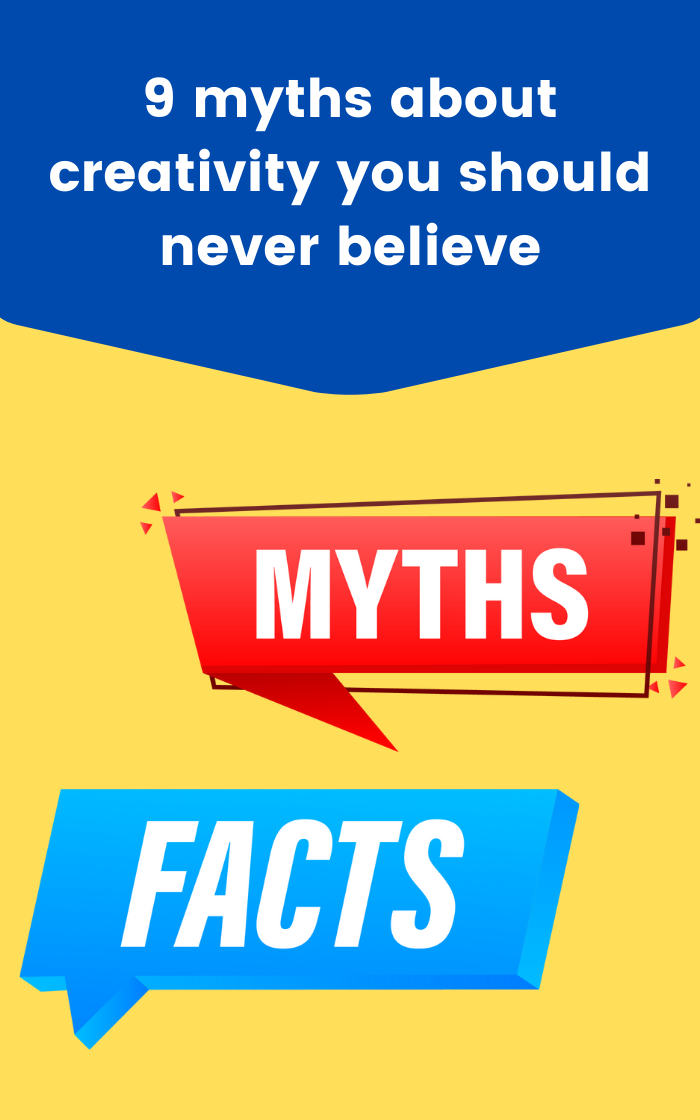9 myths about creativity you should never believe

Parent Post
Here are nine famous
Here are nine famous beliefs about innovation and creativity. They simply make sense to people, but they are not true. Here is why.
Innovation = creativity
These two words are often used interchangeably.
Reality: Innovation is the organizational function of introducing new, useful, and feasible models and services. Creativity is an individual’s cognitive ability to transcend traditional ideas, rules, patterns, and create meaningful and original ideas.
The relationship between the two can be described as: Innovation is the implementation of creative ideas.
Innovation requires significant resources
Innovation requires significant resources and funding.
Myth: The more R&D dollars you spend, the more innovative your company will be. You need to give your creative people every resource they need.
Reality: There is no evidence that the amount of money invested in R&D yields better creativity. You have to be more creative when you have less resources because you have to do more with less and it kind of spurs the creativity process.
Innovation = Entrepreneurship and
Innovation = Entrepreneurship and startups
Myth: Innovation cannot be achieved by mature, large companies. Only by startups.
Reality: While most innovation comes from startup companies, some of the top innovative companies like Apple are mature and large. The myth acts as a self-fulfilling prophecy and deters large companies from attempting to innovate like startups.
You need to build
You need to build an innovation space and allocate time for creativity.
Myth: Innovation cannot happen while an employee is doing her “day job” in her office. You need to build an innovation lab and put employees there to be innovative.
Reality: You can only create an environment in which employees and teams will become more creative, and processes for the organization to implement the best ideas. But this environment needs to exist seven days a week,24 hours a day, and in every office and meeting room.
You were either born
You were either born creative or not.
Myth: Creativity cannot be learned or exercised.
Reality: Creativity is learned and can be exercised, like every other muscle in your body. It can be affected by your practices, how you expose yourself to old ideas, procrastinate to let them incubate, and relax to let them happen. Great ideas might feel accidental, but they are not.
Financial incentives increase creativity.Myth:
Financial incentives increase creativity.
Myth: People work here for the money. So why not promise a bonus for great ideas? Often, companies offer bonuses for filing patents.
Reality: Not only do financial incentives fail to increase creativity, experiments show that they actually reduce it. Financial incentives have been proven to increase productivity on simple and repetitive tasks.
Innovation initiatives need to
Innovation initiatives need to be implemented throughout the entire organization.
Myth: The problem with innovation is that it has to be implemented throughout the entire organization.
Reality: There is no doubt that the company needs to adhere to external regulations, but you also need to know where your creative “core” needs to be, and release those people from processes that stifle creativity.
Your “creative core,” the team (or teams) responsible for developing new ideas, needs to be free of bureaucracy and regulations that do not apply to them.
There is nothing you
There is nothing you can do to increase innovation organically in your company.
Myth: If your company “lost its innovative edge,” it is irreversible.
Reality: Companies can increase their creativity levels. First, hire more creative people. Second, create a climate that motivates those individuals to be more creative. And third, institute an effective mechanism of self-selection of creative ideas to implement them.
You need to drive
You need to drive innovation.
Myth: Innovation will not happen by itself. If employees are given a choice, they will not innovate. You, the executive, need to be the driving force behind innovation.
Reality: Driving innovation is not effective. You cannot force employees to be creative, but you can let them know that trying things and failing is acceptable.
Promote the behaviors that increase creativity, and eliminate behaviors like bureaucracy, internal politics, and internal competition.

